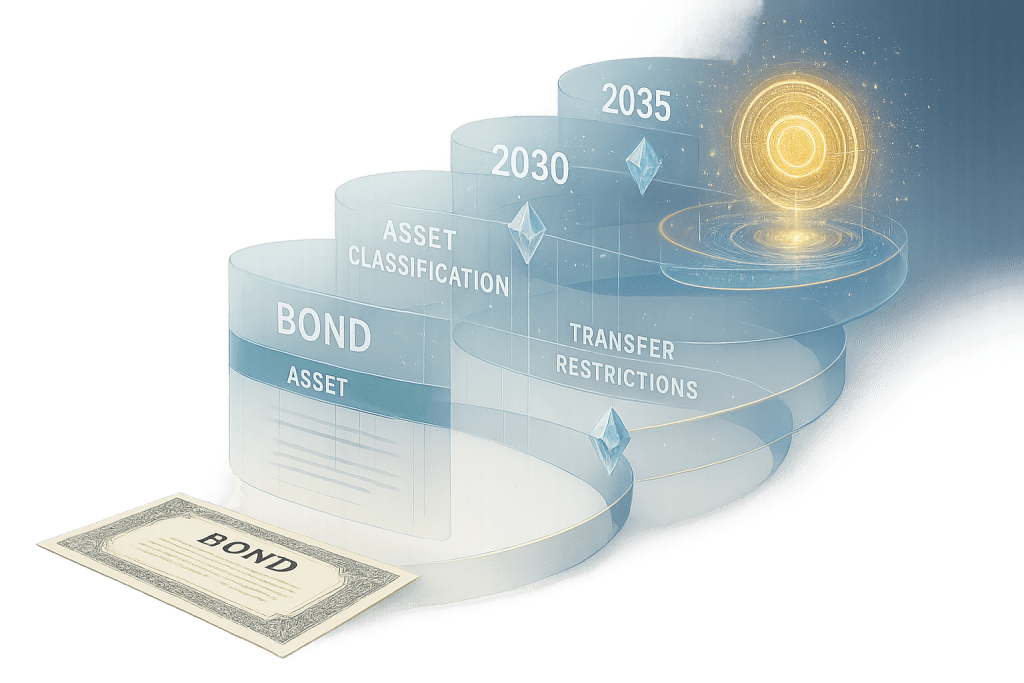TL;DR
Blockchain’s irreversible temporality and fully-connected spatiality exhibit remarkable isomorphism with modern physics’ concepts of spacetime. Within this digital spacetime, the oracle state machine emerges not as mere technical innovation, but as an inevitable evolutionary stage in information physics. Just as quantum gravity unifies classical mechanics and quantum mechanics, Oraclizer realizes a theoretical leap that connects separated information spacetimes into one unified information universe. This reveals the ontological inevitability of blockchain’s evolution from localized information preservation to global state synchronization.
One early morning, after wrestling with code all night, I had a sudden realization. What we were building wasn’t just another oracle system. As I watched the blockchain’s block hashes linking together, a lightning bolt of insight struck me – this was the spacetime of a digital universe.
Blockchain: The Implementation of Digital Spacetime
After years of researching blockchain, I’ve felt that this technology transcends being merely a distributed ledger. The answer, surprisingly, lay in physics’ most fundamental concepts.
Time’s Directional Acyclicity = Blocks’ Irreversible Linkage
Each blockchain block contains the previous block’s hash, precisely matching time’s arrow. Once created, a block cannot be reversed – it only moves forward. This has the same mathematical structure as the directionality of entropy increase described by the second law of thermodynamics.
Space’s Non-directional Complete Connectivity = P2P Nodes’ Simultaneous Expansion
Meanwhile, blockchain network nodes operate like space. Any node can connect to all others, and information propagates instantaneously. This resembles the non-locality exhibited by quantum entanglement.
This recognition posed a new question: If blockchain truly is digital spacetime, what are the current isolated chains?
The Unfinished Symphony of Information Physics
Current blockchains each form their own information universe. Ethereum in its way, Bitcoin in its way – each evolves independently in its own state space. Like physics before general relativity, these are worlds perfect locally but disconnected globally.
From an information theory perspective, this represents serious fragmentation of information preservation. Shannon’s information entropy measures system uncertainty, and separated chains have complete uncertainty about each other’s states:
“True information preservation must be global. Local preservation is merely partial truth.”
– Rolf Landauer, “Information is Physical” (1991)
At this point, I saw the inevitability of the oracle state machine.
Oracle State Machine: The Unified Theory of Information Spacetime
As quantum gravity seeks to unify quantum mechanics and general relativity, the oracle state machine unifies separated information spacetimes. But this isn’t just a simple bridge. It’s a new paradigm of complete state synchronization.
The Mathematical Inevitability of State Synchronization
Information preservation’s unitarity is a core principle of quantum mechanics. As the black hole information paradox shows, information cannot be destroyed – it can only be transformed. The oracle state machine extends this principle to cross-chain environments:
\(\phi_{32}: State_{L3} \rightarrow State_{L2}\)
\(\phi_{32}(s) = (h(s), \pi_{32}, metadata)\)
Where \(\pi_{32}\) is the zk proof of state transition, mathematically guaranteeing information completeness.
Entropy and State Synchronization
The relationship between state synchronization and entropy reveals a profound truth about information physics. At first glance, synchronizing disparate blockchain states might seem to violate the second law of thermodynamics – after all, we’re creating order from disorder. But this apparent paradox dissolves when we understand the deeper mechanics at play.
Consider the dual nature of entropy in our system. Shannon entropy measures the uncertainty in blockchain states across different chains. Before synchronization, each chain exists in complete uncertainty about others’ states – maximum informational entropy. The oracle state machine reduces this uncertainty, seemingly decreasing entropy.
Yet this mirrors the resolution of Maxwell’s demon paradox. As Landauer proved, information processing itself has thermodynamic cost. The computational work required for state synchronization – the zk proof generation, the D-quencer consensus, the cross-chain verification – all consume energy and increase the universe’s total entropy.
More fundamentally, state synchronization represents entropy transformation rather than reduction:
- Information entropy redistribution: Uncertainty shifts from inter-chain relationships to intra-chain complexity
- Temporal entropy flow: The irreversible time arrow of blockchain ensures entropy always increases globally
- Quantum entanglement analogy: Like entangled particles, synchronized states maintain total information while reorganizing correlations
This reveals why the oracle state machine is thermodynamically inevitable. Just as gravity emerges from entropy gradients in some theories of quantum gravity, state synchronization emerges as the natural response to information entropy gradients between isolated blockchain universes.
Ontological Inevitability: Why Oracle State Machines?
During sleepless nights pondering this problem, I realized: The oracle state machine isn’t a choice – it’s an inevitability.
The Demand for Information Completeness
If blockchain is truly digital spacetime, information completeness must be guaranteed. The fragmentary data points provided by current oracles are like seeing only shadows of three-dimensional objects. The oracle state machine enables a holographic projection of complete states.
Preservation of Causality
In physics, causality is a sacrosanct principle. The oracle state machine’s D-quencer algorithm guarantees causal ordering even in distributed environments. This isn’t merely a technical choice – it’s essential for digital spacetime consistency.
Regulatory Compliance: The Interface with Reality
Here came the most surprising insight. Regulatory compliance (RCP) wasn’t just a legal requirement – it was the interface condition between digital and physical spacetime. Just as boundary conditions determine solutions to physical equations, RCP defines the interaction between two worlds.
Reflections on the Future
Writing this, I feel once again that we’re not merely developing technology but constructing a new form of reality. If blockchain is digital spacetime, the oracle state machine is like the gravitational theory that unifies that spacetime.
As physicists search for quantum gravity, we’re implementing information gravity. This isn’t mere metaphor – it’s a mathematically isomorphic structure. Time’s irreversibility, space’s connectivity, information preservation – all converge in the oracle state machine.
Perhaps decades from now, people will recall today’s era of separated blockchains like the classical physics era. And they might remember the oracle state machine as the relativity theory of information physics.
But for now, we’re still assembling the pieces of this grand puzzle. Every early morning, encoding the universe’s secrets line by line.
Learn more
To explore deeper connections between oracle state machines and information physics:
- Oracle State Machine: The Dawn of a New Paradigm – Technical foundations of the oracle state machine
- Oracle Technology Evolution: From Data Points to State Transitions – The evolution of oracle technology
- Oraclizer Official X (Twitter): https://x.com/Oraclizer
References
- Landauer, R. (1991). Information is Physical. Physics Today, 44(5), 23-29.
- Nakamoto, S. (2008). Bitcoin: A Peer-to-Peer Electronic Cash System. https://bitcoin.org/bitcoin.pdf
- Buterin, V. (2014). Ethereum: A Next-Generation Smart Contract and Decentralized Application Platform. https://ethereum.org/whitepaper/





